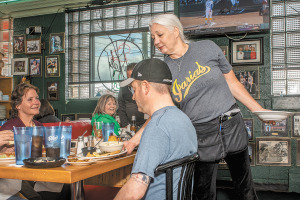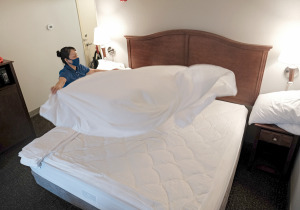Subscriber Benefit
As a subscriber you can listen to articles at work, in the car, or while you work out. Subscribe Now
The last couple of years were an unpleasant blur for Carla Russell, a manager and part owner of Iaria’s Italian Restaurant. When the pandemic hit, the landmark eatery faced exactly the same trials and tribulations as pretty much every other U.S. dining establishment: no customers, no revenue, and no way to keep their staff on the payroll.

“I’d never been through anything like that before, and for a business owner it was a very emotional hit,” Russell said. “We were trying to change our complete business model in 24 hours.”
Iaria’s pared its staff to the bone, trimmed its menu options, set up a brisk patio business when the weather and COVID regulations permitted, upped its carryout game, and did a thousand other things to help weather the storm. Nowadays its dining room is back in business, and loyal customers are returning in droves.
But the restaurant isn’t out of the woods.
“Iaria’s is extremely blessed that we’ve had core people who have stuck with us through all of this,” Russell said. “But I think normal is still a way off, and I don’t like the words ‘new normal.’ I think some places are figuring out how to make it work, but I cannot say that at Iaria’s we have yet.”
Her views are echoed throughout the central Indiana’ hotel and restaurant industries, the two portions of the U.S. economy hardest hit by the pandemic and still struggling the most to find their footing. According to the National Restaurant Association, the food service industry by itself is the nation’s second-largest private-sector employer, with some 14 million people working at almost a million eating and drinking establishments.
Therein lies the industry’s biggest problem. Restaurants, just like hotels, had to let most of their staffs go because there was no one for them to serve. But now that business is picking up again, many of those former restaurant and hotel staffers have moved on to other professions, creating a near-intractable labor shortage that, when coupled with irksome supply chain issues and rising fuel prices, conspire to complicate their recovery.
The staffing dilemma
For Russell, supply chain issues are a minor irritant that’s forced Iaria’s to pare back its menu somewhat and accept the fact that it can’t always get the custom monogrammed napkins it prefers. But such issues pale before the staffing quandary.
“Trying to bring in new people has been a disaster,” Russell said. “It’s been a nightmare.”
Employee retention has always been a bugaboo for restaurants, but the pandemic vastly magnified it. According to a survey by the National Restaurant Association, in 2022 roughly half of all restaurateurs expected recruiting and retaining staff to be their biggest challenges—up from roughly a third in pre-COVID 2019.
Iaria’s has been fortunate in luring back many of its longtime staffers, but it still isn’t up to full strength. What’s truly annoying is trying to figure out exactly what’s keeping potential hires away. Iaria’s regulars tip strongly, the place is closed on Sundays and Mondays, and it’s only open from 4:30 p.m. to 9 or 9:30 p.m. the rest of the week. So, it’s not exactly a grinding schedule.
But it is a schedule. Russell wonders if potential workers, after a very long time at home, are more inclined to pursue jobs where they can set their own hours—perhaps by doing warehouse work or food-delivery gigs.
“We’re operating mostly at 100%, but not quite 100%, because on any given day we may have to close a section because we don’t have enough servers,” Russell said. “I don’t have enough servers, and I honestly can’t get people to apply. And when they do apply, they don’t show up for the training or don’t show up for the first shift.”

Eddie Sahm, chief operating officer of Sahm’s Hospitality Group, faces the same problems but on a slightly larger scale. Sahm’s lineup of 14 eating and drinking establishments spans the state, from Big Lug Canteen in Nora to Sahm’s on the Hills in Attica. The company also runs a catering business. It had to shelve that during COVID, but it is slowly coming back.
“It wasn’t like business dropped by 50%,” Sahm said. “It went down to zero.”
The company is currently rebuilding, but its catering efforts are hindered by the same problem bedeviling all restaurants—staffing.
“The hardest part on the road to recovery is building our teams back,” Sahm said.
Losing competent staff hit hard, but in more ways than one. For instance, when Sahm’s let veteran managers and staffers go, a lot of the company’s institutional memory went with them.
“I think everybody, across the board, has had something like this happen,” Sahm said. “Keeping your brand identity and cultural values is hard to do when you’ve lost such integral pieces of your staff—because local restaurants don’t have 200-page handbooks and corporate videos and national trainers that fly around the country.”
Those big restaurant chains have those 200-page handbooks and trainers, but they have other advantages as well. For instance, when supply chain issues limit the availability of, say, chicken breasts, first dibs (and the best price) go to the folks who purchase them by the truckload.
“Chik-fil-A has a complete hold on the chicken market,” Sahm said. “They’re charging 50% of what I’m charging for a chicken sandwich. It’s hard to compete with that. There’s a sense that small, local places are just trying to keep their heads above water.”
It’s also hard to compete with the cash reserves and lines of credit that a McDonald’s or a Panera can bring to bear.
Hotels also feel pinch
Perhaps the only other large sector to suffer as much as the restaurant industry is the hotel industry. The Bureau of Labor Statistics says the leisure and hospitality industry lost some 3.1 million jobs during the pandemic that have yet to return.
Visit Indy has some interesting numbers about downtown hotel vacancy rates. They show that the recovery in room rentals still has a way to go.
For the first two months of 2022, Indy’s downtown occupancy were at 46.7%, with a daily average rate of $185.

Compare that to the first two months of 2019, when downtown hotels were at 67.6% occupancy, with a daily average rental rate of $163.40.
Still, Visit Indy said that, at least when it comes to room occupancy, the trends are pointing in the right direction.
“Based on our projections, Indy’s tourism industry will be fully recovered by the first quarter of 2023,” said Chris Gahl, senior vice president of marketing at Visit Indy. “This is based on business on the books, our sales pipeline towards booking future conventions, and travel sentiment research.”
But that recovery is still imperiled by the fallout from draconian staffing choices that came during the very first days of the pandemic.

“It was the great unknown,” said Jim Dora, president and CEO of General Hotels Corp., whose collection of 60 hotels includes Crowne Plaza Indianapolis Downtown Union Station, plus a slew of Hampton Inns, Homewood Suites, Comfort Inns and Holiday Inns, almost all of them in Indiana. “Information was choppy, and business literally stopped coming in the door. We had to make difficult decisions, and unfortunately had to lay off a ton of good people.”
As the pandemic restrictions ebbed, business at the company’s select-service hotels (such as Hampton Inn) and extended-stay hotels (such as Homewood Suites) has recovered more quickly than at full-service properties such as Crowne Plaza in Union Station. Crowne Plaza is particularly reliant on convention and sports event business. Trouble is, the convention trade is one area of travel that has not bounced back quickly.
“The health department did a fantastic job of figuring out how to keep some convention business going in a safe manner during the pandemic,” Dora said. “And the city was doing more safe events than anybody across the country was. But getting attendees to come back has still been slow.”
As with the restaurant business, hoteliers are also struggling to find enough employees. A large percentage of their old staff have moved on to other professions, leaving a gaping hole the industry is still struggling to fill.

“I could hire hundreds of people right now, in every position, across my company,” Dora said. “Everything from front desk to salespeople. Finding good-quality people is a challenge.”
Maintaining a hotel when you don’t have enough cleaning staff on the payroll takes a bit of strategy. For instance, many of the company’s locations enjoy up to 90% weekend occupancy, but during weekdays as little as 10%. That means that if the staff needs a couple of days during the week to clean up all the weekend rooms, that’s OK. Not ideal, but OK.

“You’re not flipping the house in one day,” Dora said. “Maybe it takes three days to have everything ready for next weekend.”
Jeffrey Brown, CEO of Schahet Hotels, which has nine properties (including Holiday Inn Indianapolis Airport) and two projects under development, used similar strategies to keep his company solvent during the pandemic, including looking for more contract bookings and slashing the payroll.
“We probably went from about 290 associates to maybe 80 overnight,” Brown said.
Leisure travel rebounding
Over the last year or so, as the worst of the pandemic lockdown abated, Brown has seen promising strength in the leisure travel segment.
“That market really helped us through a lot of the pandemic, because people didn’t want to stay cooped up in their houses,” Brown said. “It’s a market that’s only gotten bigger, and it’s helped us a lot in staying above the line.”
He’s the last person to say that things are back to normal, however. Or that “normal,” as it was perceived pre-COVID, may ever return.
“There is no normal anymore,” Brown said. “Everybody’s patterns have changed over these two years and a lot of people are doing things differently. We still don’t see a lot of corporate business like we saw before, but I can tell you we’ve had some good months. In fact, this past March, we had some hotels that actually exceeded what they did in 2019.”
One of their strongest performers is the Holiday Inn Indianapolis Airport, because it’s in a prime position to take advantage of the uptick in travel. Their northside Indianapolis property is snapping back less quickly, because it relies on the still-sluggish business travel niche.
Not surprisingly, supply chain snags have affected the hotel industry just as much, if not more, than the restaurant business. For instance, Brown’s company built a hotel in Chesterfield, Missouri, that broke ground right before the pandemic. Initially its furniture was to be imported from China, but during the lockdown the shipping costs to get it to the U.S. more than doubled.
“We started looking around domestically for furniture for our guest rooms,” he said. “With shipping costs doubling, we could afford to buy it from a domestic source.”
Not that getting stuff from local vendors is some sort of cure-all. That Chesterfield hotel was supposed to open on Valentine’s Day, but because of various holdups didn’t debut until March 23.
“I was just getting in tabletops for the dining room and for the lobby area,” Brown said. “So, it’s been an ongoing problem. Things are getting better, and it’s not as bad as it was six months ago, but it’s still an ongoing problem.”
At least they had all the TVs they needed, thanks to Brown’s decision to purchase them six months before the hotel opened and store them in a warehouse. But that’s just the sort of one-off, on-the-fly adjustment that hoteliers and restaurateurs are making in order to get back to routine operations. Not necessarily a return to pre-COVID conditions, but a new, more predictable, business-friendly status quo.
Unless, of course, there’s another COVID outbreak that triggers some sort of lockdown. But Russell at Iaria’s doesn’t spend much time contemplating that possibility because there’s only so much anxiety she can tolerate.
“There’s a part of me that will not allow myself to have that thought,” she said.•
Please enable JavaScript to view this content.

Tired of paying a high price for less service.
IBJ- would now be a good time to do a follow up interview with Pothole and Caine? You remember them, the fun loving couple who sat at full salary, while threatening business owners with “you’re lucky to be open at all” and making footloose jokes. Maybe they have some ideas on how to help.
I have almost no empathy at this point for the service sector. After treating employees like a disposable tissue, they claim not to be able to find decent employees? Right, that’s a good trick to use…
But for those who do, they’re hiring the lowest quality people the seemingly can find. People who can’t be bothered to do the job as is. I’ve pretty much given up hope on going out for dinner as service is so craptacular that I’ve had to give up on a number of fairly reliable restaurants. My family has been forgotten for being served, had cold food delivered, take-away meals completely screwed up, been berated for merely showing up to actually pay for the thing we wanted… That’s just locally…I’ve heard similar horror stories from around the country from family and co-workers.
Now the hoteliers — you guys are a blinking joke…and I”m extremely happy to not have to travel at the moment…
A family member recently returned home with an infestation of bed bugs after staying at a branded hotel. Several of my co workers have walked into rooms that were obviously uncleaned and been infested with all sorts of creepy crawlies…
You claim you’re saving the environment by -not- changing sheets — when it seems like you’re -not- doing just the basics to ensure a safe and fun visit. If one has to fumigate their belongings after a hotel stay because the property won’t do the right things, then something needs to change.
THings are a mess…and it’s going to take some serious redesign of customer experience, employee experience, management expectations, and fiscal structuring to get this whole sector back working properly. And given the number of people who espouse “thinking is hard” and won’t change, the problem will constantly be pointed at and not resolved. Those who do that and own businesses should not be surprised to find themselves out of customers and employees…
Follow the golden rule — treat others the way you want to be treated…
How is this news? This is nothing “new”. For the ones who are just emerging out of their basements, news alert, restaurants and hotels have been busy for a year now, probably longer for many… I’ve experienced it first hand with sales records for well over a year now. Numbers keep growing too. Labor across the service industry is extremely difficult with little to no solution or end in sight. Not just restaurants and hotels.
For people like Chris H who find themselves pissed; for sure its frustrating, but owners/operators are trying to make a living too or maybe at minimum cover their obligations. What should they do, quit because they dont have enough help providing perfect service for the complainers like yourself? Shut down and then get on unemployment? Doubtful, they’re business owners and will struggle through it working towards smoother sailing. Maybe you would have a better understanding if you had experience walking in their shoes. Maybe you would have a better attitude, come back out of your basement, try some new places, maybe travel… Or maybe you should open your own place with a redesign of customer service…